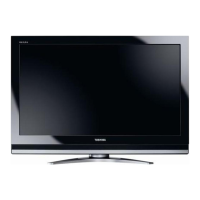
Do you have a question about the Toshiba 37X3000A and is the answer not in the manual?
| Screen Size | 37 inches |
|---|---|
| Resolution | 1920 x 1080 |
| Display Type | LCD |
| HDMI Ports | 2 |
| USB Ports | 0 |
| Brightness | 500 cd/m² |
| Aspect Ratio | 16:9 |
| Response Time | 8 ms |
| Viewing Angle | 178° |
| VGA Input | Yes |
| Component Input | 2 |
| Built-in Tuner | Yes |
| Sound Output | 10W x 2 |
Key safety precautions for TV installation and use.
Instructions for safely installing the TV unit.
Rules for safe TV operation and placement.
Actions to take for TV issues and service needs.
Steps for safely cleaning the TV cabinet and screen.
Information on LCD screen care, interference, and temperature.
Connecting an antenna for optimal signal reception.
Installing remote control batteries and exploring TV features.
Identifying and using buttons on the TV's body.
Details of all input/output ports on the TV's rear.
Explains the purpose of each button on the remote control.
Steps to turn the TV on, off, and into standby mode.
Guide for initial channel scan and location setup.
How to navigate and use the TV's on-screen menus.
Summary of available digital TV settings.
Summary of available analog TV setup options.
Process for automatically scanning and tuning digital channels.
Steps to manually scan for missing digital channels.
Presetting analog channels using the auto tuning function.
Customizing analog channel positions and labels.
Navigating and viewing digital TV channels.
Quickly switching between two selected channels.
Changing the on-screen display language.
Showing channel, audio, and subtitle status.
Details on the I-Plate display content and timing.
Rearranging analog channel order.
Customizing how long the I-Plate information is shown.
Choosing between 24-hour or AM/PM display.
Adjusting image aspect ratio for optimal viewing.
Adjusting picture for PC connections.
Freezing the current TV image.
Restoring picture position to factory defaults.
Choosing preset picture quality modes.
Fine-tuning contrast, brightness, color, tint, sharpness.
Using MPEG NR and DNR for noise reduction.
Adjusting picture color tone (Cool, Normal, Warm).
Fine-tuning individual color components.
Improving dark area detail for better definition.
Restoring color settings to factory defaults.
Automatically adjusting brightness for dark scenes.
Optimizing picture for 24fps film content.
Managing stereo and bilingual audio modes.
Choosing Dual 1 or Dual 2 audio for bilingual broadcasts.
Manually selecting stereo or mono sound.
Activating virtual surround sound and bass boost.
Limiting volume fluctuations.
Displaying blue screen and muting sound when no signal.
Controlling the brightness of the TV's side panel indicators.
Manually setting the TV's time zone.
Scheduling TV to switch to a channel at a specific time.
Scheduling TV to turn on to a specific mode or channel.
Setting TV to automatically turn off after a period.
Choosing the active video input for viewing.
Manual adjustments for analog TV settings.
Choosing between Auto and LIST teletext modes.
Viewing teletext pages automatically or by number.
Viewing and managing favorite teletext pages.
Functions of specific teletext buttons on the remote control.
Viewing teletext information on digital channels.
Accessing and using the Electronic Program Guide.
Setting up parental controls and channel locks.
Limiting program access based on age ratings.
Favorite, lock, and skip settings for channels.
Creating and using a list of favorite channels.
Turning closed captions (subtitles) on or off.
Resetting all TV settings to default.
Selecting audio modes, output formats, and MPEG levels.
Adjusting the transparency of on-screen displays.
Connecting external devices to TV back terminals.
How to connect TV audio output to an amplifier or receiver.
Wiring for Dolby Digital sound systems.
Wiring for amplifiers with optical/coaxial inputs.
Wiring for MPEG audio systems.
Connecting devices to the TV's side ports.
Connecting digital video sources via HDMI/DVI.
Specifics for connecting HDMI sources.
Specifics for connecting DVI sources.
Choosing audio input for PC or HDMI1.
Selecting audio mode for HDMI1 input.
Configuring TV output for analog, digital, or monitor.
Wiring a PC using an analog RGB cable.
Wiring a PC using HDMI or HDMI-to-DVI.
Adjusting picture size, position, clock phase, and sampling.
Solutions for TV not turning on, no sound, or poor picture.
Resolving signal reception and teletext issues.
Explains parental rating codes and blocking settings.
Details color and sound systems used globally.
Technical specs for the digital TV tuner.
Physical size, weight, and resolution details.
Comprehensive list of all TV ports and their functions.
Environmental limits and included items.
